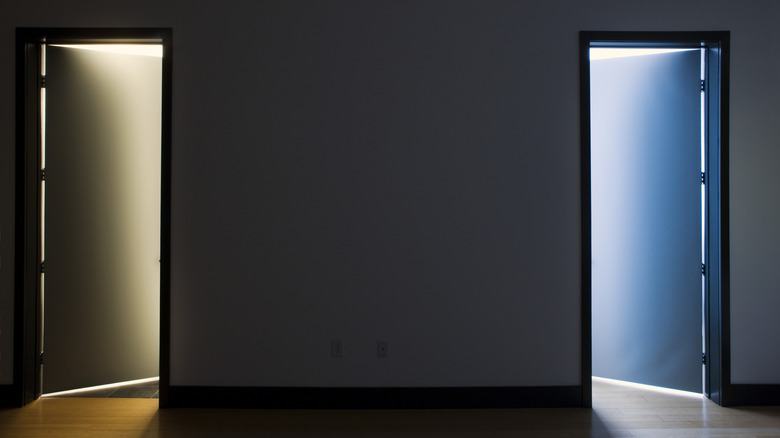Daylight Vs. Bright White Bulbs: Are They The Same Thing?
Few elements of interior design can change a space quite as much as lighting. While the location of the lighting is a big part of that equation — particularly with home theater setups — the light bulb installed in each lamp or fixture is every bit as important, as it is ultimately the element that dictates the level of brightness within the room, and thus creates the overall ambience therein.
In days of old, choosing light bulbs wasn't particularly tricky, as there just weren't that many styles to choose from. These days, perusing the lightbulb aisle in a store can be a headache-inducing prospect due to the sheer number of different bulbs available, with smart lighting options only making things more complicated. Apart from the breadth of options, discerning the subtle and not-so-subtle differences between bulbs bearing labels like Soft White, Warm White, Daylight, and Bright White can also be difficult.
Those last two styles are common to come across in the lightbulb section of any store. And to answer the question at hand, they were given different names because they provide different levels of light, each producing a noticeable difference in color temperature in the rooms they illuminate. Given that Daylight and Bright White bulbs are, in fact, not the same thing, the obvious question becomes just how different they actually are. To answer that question, we'll need to dig a little deeper into the specs of each style of bulb.
The bulbs provide a stark difference in room aesthetic
Given that color temperature is the primary difference between a Bright White bulb and a Daylight bulb, the one you choose ultimately depends on the general aesthetics you're looking for in the room they illuminate. To break down the difference between the bulbs in as simple a way as possible, we can tell you the general rule is that Bright White bulbs deliver a warmer room tone, with Daylight bulbs providing a level of brightness befitting their name.
Color temperature with lighting is measured in a unit called Kelvin, which can range from 1,000k on the lower end to 10,000k on the high end. However, commercial and residential lighting tends to stay between 2000K and 6500K. In terms of the ambience those Kelvin ratings produce, bulbs on the lower end tend to create a warmer light in the room that is better suited for a calming, cozy vibe. Meanwhile, bulbs that err on the higher side of Kelvin cast a crisp, bright light for rooms in which you prioritize visibility over vibes.
With all we've already covered, it'll come as little surprise that Bright White bulbs are generally rated between 3500K and 4100K, while Daylight tends to range between 5000K and 6500K. Those ratings would seem to make Bright White the more balanced, middle-of-the-road option for folks who don't want their room too bright or too dark. But for rooms in which you need a cooler, more natural light, Daylight may be the way to go. And just for the record, both styles of bulbs should be available in LED models.

